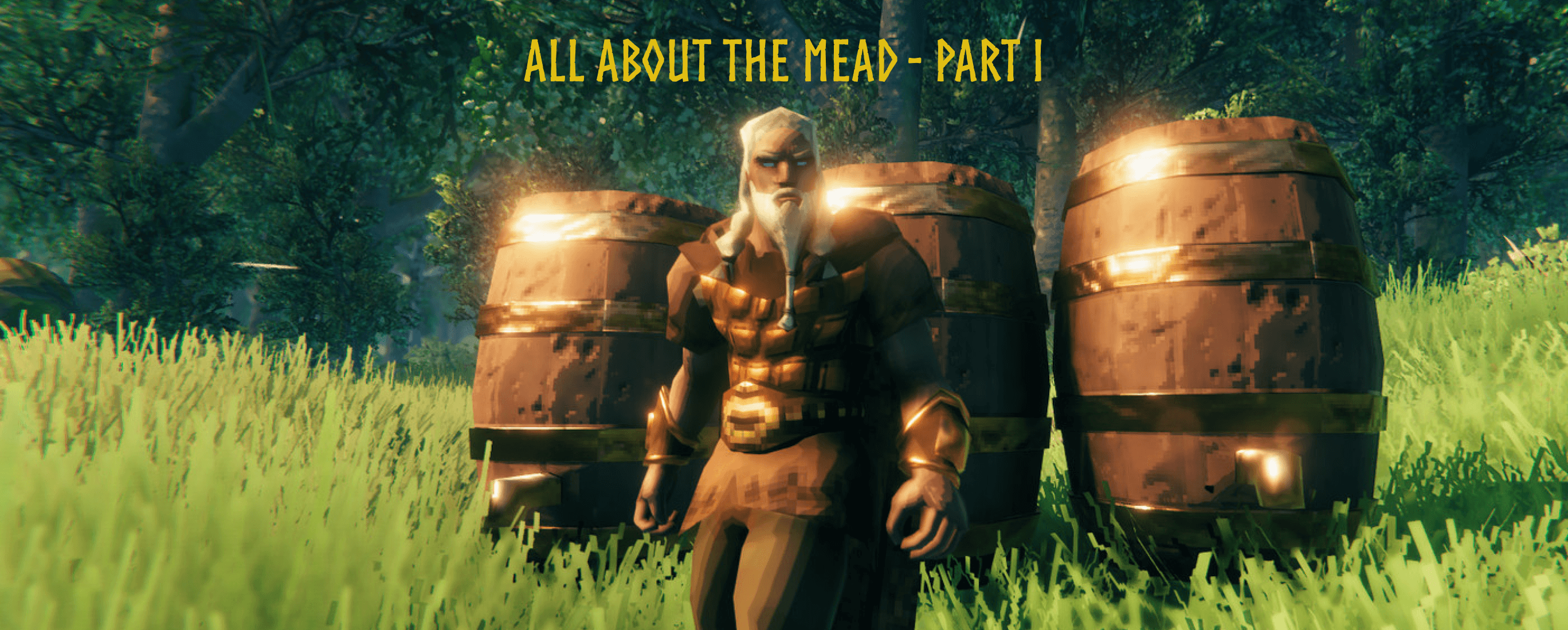
 Christopher R. RiceApr 7, 2023
Christopher R. RiceApr 7, 2023In Valheim, one of the very important aspects of the game is brewing potions that offer instant healing, resistance to certain types of damage, restoration of eitr (magic), and so on. What I think I find most interesting about Valheim's potion system is that it’s based on an alcoholic drink. In this case, mead. Now, historical medicinal liquids, “potions,” and the like are no stranger to having alcohol mixed into them (this is often called a “tincture”), but in Valheim, the mead is always the base of the potion, and other things are added to create an elixir. In game, this usually takes a while, as the potion ferments to become ready.
Given all that, I thought we’d talk about mead this month, in a two-part special about its historical connotations, myths surrounding it, portrayals in popular culture, how it’s made, how you can make it yourself, and speculation about its purpose and origin within the Valheim universe.
Historical Mead
Mead is an alcoholic beverage made by combining honey and water and letting it ferment for several weeks. Occasionally, yeast is added to accelerate the process. Other herbs – such as cloves, ginger, rosemary, thyme, and so on – may be added to “spice it.” Some versions also used various fruits to add a further depth of flavor, such as the one from the seventh millennium BCE in rural China. It might also have been used as a base for other drinks (such as Vedic soma), which were then prepared with other ingredients. The word “mead” is derived from the Proto-Indo-European word “médʰu,” which meant “honey” or “honey wine.”
Most interestingly, mead might have been around before agriculture, beekeeping, and ceramic pottery itself. How? Historians have speculated that Paleolithic hunter-gatherers would flood a found bee’s nest with water and wait for it to ferment before gathering it up to drink. The idea that we were fermenting stuff in the wild like this is utterly fascinating. Our ancestors weren’t stupid – despite portrayals in popular culture that presents it otherwise. Imagine being the hunter-gatherer who's after some honey they spotted a few weeks prior, finding the nest all soggy and flooded out, and going, “Yeah. Sure. It could still be good. I really want some of that honey, bruh.” And then realizing that not only is it good, but it gets you wrecked. So now you and all your other hunter-gather bruhs are finding other nests, putting them in some still water and coming back for them later.
With the creation of containers via pottery and ceramics came a more controlled fermentation of mead – and also, basically everything. Humans love to ferment things. I think Anne McCaffrey said it best in her novel Dragonsdawn: “One of the first things human settlers seemed to do on any new world was to make an immediate and intensive search for fermentables, and to devise an alcoholic beverage in the quickest possible time.” The oldest record of mead fermentation we found was from an archeological dig in northern China, dating back to around seven thousand BCE, which involved a ceramic pot with traces of honey, rice, and fruit. In Europe, they found evidence of mead being fermented as early as twenty-eight hundred BCE. The earliest written record of mead is possibly the drink soma, mentioned in the Rigveda in around seventeen hundred BCE.
Mead was a popular drink throughout history and was the favorite of Aristotle, Pliny the Elder, etc. It was talked about in poems and songs (the Welsh bard Taliesin wrote a poem called Kanu y med or the “Song of Mead”), and figured in many tales. One of the most popular of these ancient works is Beowulf. If you’re not familiar, basically this badass ancient warrior comes to help a king whose mead hall is being terrorized by a monster. To lure out the beast, our hero starts feasting in the hall again, drinking lots, and eventually the critter, Grendel, shows up. Beowulf, being awesome, tears of its arm in a wrestling match and it slinks back to its lair to die. Even Beowulf’s name (“bee wolf” or “bee hunter”) is related to one of the ingredients needed to make mead itself… Coincidence? Maybe, but still fascinating to think that honey was important enough that they named one of our greatest culture heroes after it.
One interesting historical fact about mead is that it played a significant role in the creation of the Magna Carta, a foundational document of English law. In 1215, King John of England held a meeting with his barons at Runnymede, where they negotiated the terms of the Magna Carta. The negotiations were reportedly aided by copious amounts of mead, which helped keep the mood light and jovial during the tense negotiations.
Mythological Mead
In mythology (as we’ve discussed some previously), mead holds a rather important place in many cultures. It’s often the divine drink of choice and depending, on the mythology, has a mystic origin. For example, in the historical Vedic religion (and much later on Hinduism), mead is thought to either be the magical drink soma or to be part of its making. In Norse mythology, after the gods wars with themselves and then come to a truce, they create a being from their spit named Kvasir – a being with the collective wisdom and knowledge of all the gods. He could answer any question and could not be confounded. Eventually, he was allowed to go to Midgard and help mankind become better, but then he was confronted by two dwarves. These dwarves killed him and mixed his blood with honey, herbs, and spices to create “the mead of poetry.” From then on, whoever imbibed the mead was instantly a scholar or poet of great renown.
Mead was not only thought to be a curative, but a restorative to, uhhh, sexual prowess. In fact, a modern term comes from a Norse tradition of giving a newly wed bride and groom a month’s worth of mead to sup on. That’s right, honeymoon – that thing where newlyweds go on a vacation somewhere romantic – was originally meant to be more a staycation with mead and spending lots of personal time with your partner. But even platonic relationships were aided by mead, with its power to bring people together.
In Greek mythology, the drink/food of the gods is called “ambrosia” and imbibing it can give longevity, immortality, or confer godhood. It was served by doves, elevated guests in Olympus (such as Ganymede), or by nymphs. It was said even a tiny sip would cleanse the flesh of those which drank it. It was alternatively something to eat, akin to fruit or drink. The latter is where mead comes into it, as it was considered to be thick and golden in color and could be “ladled.” It was also associated with love and fertility, and served at weddings.
In Celtic mythology, mead was associated with the goddess Brigid, who had the power to transform into a bee. Bees were also associated with wisdom and poetic inspiration, and mead was seen as a sacred drink that could bring these qualities to those who consumed it.
In Slavic mythology, mead was known as medovina and was associated with the gods and the afterlife. The drink was believed to have the power to grant eternal life and was often used in funeral rites as an offering to the deceased.
Overall, mead has been an important part of mythology and folklore across various cultures, representing wisdom, inspiration, fertility, and even the afterlife.
Final Thoughts
Whew! That’s a lot of stuff and we haven’t even gotten to the fun things yet, like how to make the stuff. We’ll be covering mead in popular culture, how it’s made (and how you can make it!), and speculation on its purpose and background in the Valheim universe in the next post.
As always, I leave you with questions: Have you ever had mead? Have you ever made mead before? If so what was your method and/or recipe? We here at haptic would like to know!

Play on Haptic
Try for free


